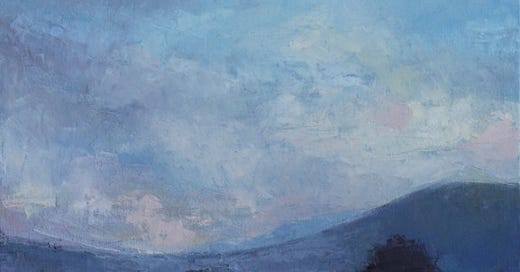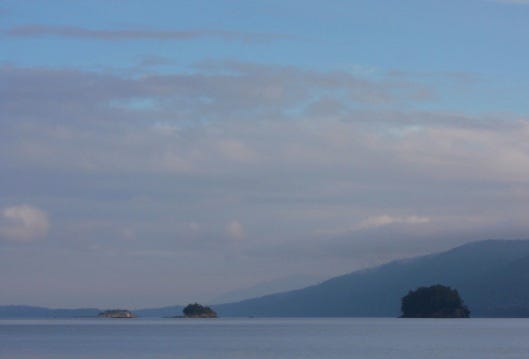Art points to something beyond itself, toward that “something more” we sense in things and can only reveal through our pen or brushes, in our music or dance.
What is this thing we glimpse in nature, in life itself, that so excites and inspires and compels us to re-create what we see in a form that we can share with others? Some see what art evokes or points a finger toward as the mystery in the midst of things.
“Art evokes the mystery without which the world would not exist.” -Rene Magritte.
“The artist’s function is to love the enigma. All art is this: love which has been poured out over enigmas – and all works of art are enigmas surrounded and adorned by love.” – Rainer Maria Rilke
“The job of the artist is always to deepen the mystery.” -Francis Bacon
“The most beautiful thing we can experience is the mysterious; It is the source of all true art and science.” – Albert Einstein
We don’t have to be artists to see it and respond to it. But artists are those who try to capture it in such a way that others see it, and feel it, too.
An example is the painting at the top of this page by Terrill Welch. She blogs about her art and the creative process at Creative Potager and generously allowed me to use her artwork here. The painting above was inspired by the following scene shown here in a photograph. On the surface, it’s a rather tame scene, nothing remarkable. It may even seem a bit dull.
Photo by Terrill Welch
Yet the artist senses something here that inspires her to paint. Her artwork brings to the surface something that had lain dormant within the natural scene, and points that “something more” the artist sensed and the receptive viewer can also sense though her work. We may interpret what this “something more” is in different ways.
Perhaps we perceive a hushed tranquility, or wondrous luminosity not apparent in the original scene. Perhaps the colors of the sky and sea in the painting, the way they blend together and echo each other, elicit an underlying sense of unity or connectedness. Or the gently flowing lines of the hills and those rounds of dark isles lying beneath evoke a soothing sense of sympathy.
Or perhaps we see something more tumultuous going on. Perhaps the tumbling texture of the brush strokes, each unique, each saturated with hues that complement and oppose each other, reveal an intricacy and liveliness that lies beneath what seems to be so simple and still.
Perhaps we see how all of this—the unity and sympathy and complexity—plays together, and we see in that something of the mystery in the midst of things.
Making art, or responding to it, takes us out of ourselves, our ordinary perceptions of reality, while at the same time, deepening what it means to truly be ourselves.
Carl Jung calls it “the state of participation mystique.” He writes: “The secret of artistic creation and the effectiveness of art is to be found in a return to the state of ‘participation mystique’ – to that level of experience at which it is man who lives, and not the individual.”
Joseph Campbell explains further: “The agony of breaking through personal limitations is the agony of spiritual growth. Art, literature, myth and cult, philosophy, and ascetic disciplines are instruments to help the individual past his limiting horizons into spheres of ever-expanding realization.”
Art does that—it breaks through, as with an ice-ax, what Franz Kafka once called “the frozen sea inside us.” And doing so, it sets us free to explore that “something more” we seek, or the mystery within the midst of things.
Here’s a fuller version of the quote from Einstein that so beautifully expresses this idea:
“The most beautiful thing we can experience is the mysterious. It is the source of all true art and science. He to whom the emotion is a stranger, who can no longer pause to wonder and stand wrapped in awe, is as good as dead —his eyes are closed. The insight into the mystery of life, coupled though it be with fear, has also given rise to religion. To know what is impenetrable to us really exists, manifesting itself as the highest wisdom and the most radiant beauty, which our dull faculties can comprehend only in their most primitive forms—this knowledge, this feeling is at the center of true religiousness.”
I’d love to hear what you think of this in the comments below.
If you enjoyed this, you might enjoy what I wrote about art and painting at the links below.
Landscapes of the Mind: Six Singular Experiences






It’s very uplifting to read this beautiful reminder of the essential mystery at the center of life, Deborah. The rational left brain is sometimes uncomfortable with that uncertainty. I’m glad you’ve pointed to art’s role in celebrating it.
I’m not surprised you’ve included Jung and Joseph Campbell among the wise humans quoted in this piece. Both have pointed the way to wholeness and truth. Both have been important to me personally. I have a feeling they’ve also influenced your journey as well. Thanks for sharing these lovely thoughts with us today.
Lovely thoughts, Deborah.
As actor & playwright Harvey Fierstein said...
“Art has the power to transform, to illuminate, to educate, inspire, and motivate.”
I will also add that art can be revolutionary and deemed dangerous to governments. Picasso's 'Guernica' is a good example, as is Goya's 'The Third of May 1808,' and with music, Fela Kuti used his music to criticize his corrupt government (Nigeria), and they damn near killed him for it (the government police and military terrorized, raped, assaulted, beat, and imprisoned Fela, his wives, his mother, his bandmates, and ultimately burned down the band's compound).
But as Duke Ellington once said...
“Art is dangerous. It is one of the attractions: when it ceases to be dangerous, you don't want it.”
Art in all its forms and our wonderful ability to be creatively curious is what sets humans apart from the rest of the animal kingdom. It has taught us everything we know about ancient societies and civilizations, and it has also left us with many questions. It allows us to internalize our thoughts and emotions; it helps us make sense of our world; it questions the world; it helps us not feel alone; it frustrates us; it teaches us to see & feel; and it ultimately unites us all.
Art makes us human.